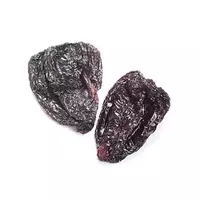Ancho

Ancho peppers bear not one, but several names, among which are poblano peppers or mulatos, but they all refer to the fruits of the chili plant, which are distinguished by medium severity. This bitter pepper comes from Mexico (Puebla), from where it came to European countries.
The heart-shaped shape of the ancho pepper pod is quite wide, while the vegetable is characterized by a flattened blunt tip. The color of the fruits is darker compared to anaheim pepper. The mature red ancho is thought to be much sharper and more attractive in appearance than this same green pepper. The length of the ancho averages from 7 to 14 centimeters with a fruit width of 5 to 7 centimeters.
In an unripe form, the dark green ancho pepper is quite bumpy, but, having completely ripened, it becomes dark red, almost black. For raw ancho pods, a sweet smell is characteristic, but it is used not only fresh, but also dried. For example, Mexicans like to stuffe or cover fresh fruits with beaten eggs, and then fry. Ancho is also used to make molé sauces.
Ancho snacks are especially popular in Mexico at a time when indigenous people and guests of the country are celebrating Independence Day. This hot pepper is an integral part of the "chiles en nogada" or chilli dish in a nut sauce made up of green, white and red components that match the three colors of the Mexican flag.
After frying and peeling, ancho peppers can be stored preserved or frozen for several months. However, the most common storage of this pepper is in dried form - in this state, the fruits become wide, flat, heart-shaped pods. Their Mexicans call them "ancho chili, " that is, a wide ancho chili.
The dried ancho pepper has a barely discernible aroma. The process of making such pepper itself involves the selection of mature red fruits, which are dried to a flat, wrinkled state and black and brown, and after a while the ancho acquire a brick-red color.
Another option for making this Mexican product is one for which mature fruits are used, but dark brown in color, which are dried to the same wrinkled state. However, the difference between such an ancho and the previous one lies in the final color: in this case, the color of the pepper remains brown even after storage. The taste of such an ancho pepper is sweeter, and in its rich aroma you can feel the notes of chocolate.
ancho 281 kCal
Energy value of ancho (Ratio of proteins, fats, carbohydrates - ju):
Proteins: 11.86 g (~ 47 kCal)
Fats: 8.2 g (~ 74 kCal)
Carbohydrates: 29.81 g (~ 119 kCal)
Energy ratio (b | y): 17% | 26% | 42%
 Español
Español Français
Français Português
Português Русский
Русский 简体中文
简体中文 繁體中文
繁體中文 日本語
日本語 한국어
한국어 العربية
العربية Türkçe
Türkçe Қазақ
Қазақ Deutsch
Deutsch Italiano
Italiano Українська
Українська
